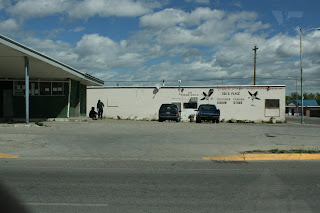Wednesday, August 18, 2010
Day Twenty-Two -- Cahokia
Tuesday, August 17, 2010
Blog Title
Monday, August 16, 2010
Day Twenty-One -- One-Liners
Nature called and I took a break at Claremore, Oklahoma I stopped the car at a filling station and made a detour nearby to the Will Rogers Memorial Museum, which is a repository for almost everything about the writer, cowboy, entertainer and humorist, among many other roles. I'm glad of the accidental stop because I learned more about him, such as his background of one-quarter Cherokee. And Claremore used to be in Indian territory before Oklahoma became a state in 1907.
Sunday, August 15, 2010
Day Nineteen -- Craters, Petrified




Meteor Crater outside Flagstaff, Arizona/Petrified Forest/Painted Desert
Saturday, August 14, 2010
Day Eighteen --Arizona Calling







Kaibab National Forest/Grand Canyon:North Rim/Vermillion Cliffs/Glen Canyon/Flagstaff
Friday, August 13, 2010
Sunsets
 This has been my typical view of a sunset after driving for about 12 to 13 hours on the road. Pretty spectacular, huh? It sure beats being indoors. Each night has been unique -- different shades of yellow, orange, red and the occasional purple. It's as if Mother Nature were painting gradually before my eyes, with the sky as her canvas.
This has been my typical view of a sunset after driving for about 12 to 13 hours on the road. Pretty spectacular, huh? It sure beats being indoors. Each night has been unique -- different shades of yellow, orange, red and the occasional purple. It's as if Mother Nature were painting gradually before my eyes, with the sky as her canvas.Day Seventeen -- Zion/Bighorn/Kobol Canyons


Lots of new stuff today. One of the major highlights was witnessing a pair of wild bighorns in the canyons of Zion National Forest, which is about an hour and a half's drive southeast of Cedar City. The goal was actually to spend time in a section of the canyons of Zion, but the only outlet for private cars in the park was a road leading out, through a 1.1 mile tunnel. Only buses were allowed to ferry people on that northern trail of Zion.
Thursday, August 12, 2010
Day Sixteen -- Canyons









Bryce Canyon/Scenic Byway 12/Escalante/Red Canyon
Great weather, colorful canyons, an impressive drive -- what more could you ask for. It would take days, at least a week, to fully appreciate what this region of Utah offers.
First step from Cedar City was a drive through Dixie National Forest, which reaches an elevation of about 8,000 feet. Then a descent through Red Canyon and oonto the next national park, Bryce Canyon.
Bryce, with its unusual rock formations, reminded me of the Badlands of South Dakota except this area had spectacular shades of red and orange. It was worth traveling along the rim of the canyon and on the hiking trails. I had ventured about half a mile into a hike toward some of the stone formations, but the hike back up was tiring. It was hot and I was breathing heavily. The workout showed how unfit I had become the past couple of weeks because of the many hours of driving and relative inactivity. I miss my bike, which I will hop back onto as soon as I return to NYC.
Anyway, there are many more trails to cover, and it'd be worth traveling back to Bryce, even for a long weekend.
After Bryce, with the clock at 5:30 p.m. and winding down toward sunset, the plan was to travel back along the Route 12 Scenic Byway and get as far as possible with enough time to head back at a decent hour to Cedar City. It was worth the trip because one stretch of the oil-slick road opened into a valley, and that photo in this blog shows how amazing the view was. Driving eastward as the sun set was ideal, and if you do this trip, you'll appreciate how the light plays a factor on this travel.
Escalante has the petrified forest and I only made it as far as the cove near the parking lot of a camping area, before heading back. It would have taken a couple of hours further to complete the route. I'll have to save that for another time.

Wednesday, August 11, 2010
Day Fifteen -- Utah

 Utah/Salt Lake City/Cedar City
Utah/Salt Lake City/Cedar CityTuesday, August 10, 2010
Day Fourteen -- More Glaciers


Cody/Scenic Route/Yellowstone/Grand Teton


Monday, August 9, 2010
Day Thirteen -- Cowboy Country





You know you're in cowboy country when tumbleweed tumbles by. Montana has a diverse landscape -- from the Rocky Mountains including Glacier National Park to the prairies of the Great Plains. In between is the desert-like conditions, and Highway 310 is pretty amazing. About 20 miles separate the nearest towns, so if your car breaks down, you're pretty much screwed. And there's no state patrol vehicles, which means you can go as fast as you like beyond the 70 mile per hour speed limit.
Saturday, August 7, 2010
Day Twelve -- Ice, Lakes & Canada
Glacier National Park/Waterton Lakes








